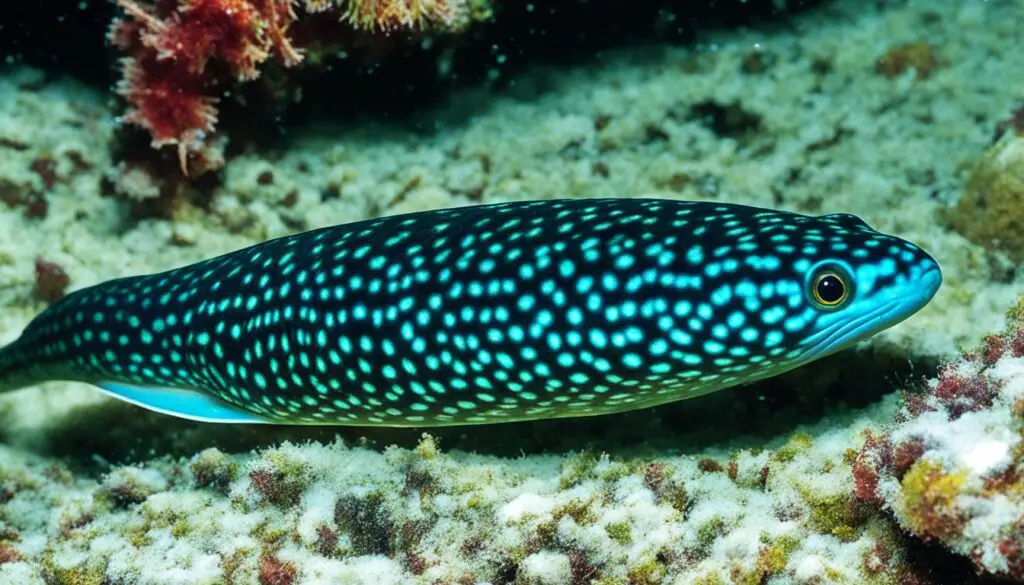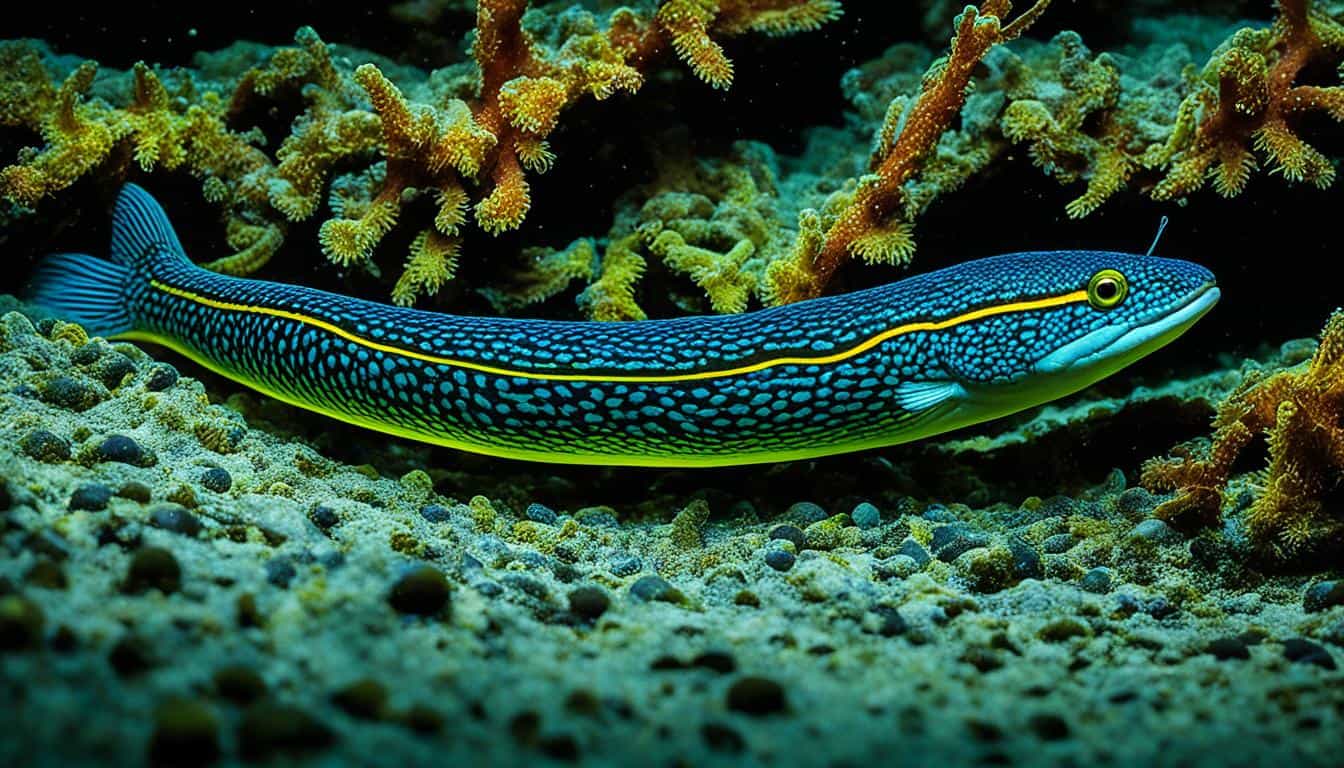Electric eels are known for their ability to produce electric shocks. They belong to the genus Electrophorus. You might ask, what are the different species of electric eels? For a long time, scientists thought there was only one type, Electrophorus electricus. But new research has found three distinct species.
This discovery helps us understand more about these fascinating creatures and their roles in their homes in South America. Each species—Electrophorus electricus, E. voltai, and E. varii—has its own electrical abilities and likes where it lives. This diversity fascinates researchers and shows how important electric eels are to our ecosystem.
Introduction to Electric Eels
Electric eels are fascinating creatures that live in the water. They are actually more like catfish and carp than true eels. These fish have a special ability to make strong electrical discharges. This helps them hunt and protect themselves from predators.
Learning about electric eels can make you appreciate them more. The first time scientists wrote about them was in 1766 by Carl Linnaeus. Since then, scientists have been studying them to learn more about their lives and behaviors.
Studying electric fish, including electric eels, helps us understand nature better. It also leads to new ideas in technology and science. Their ability to make electricity is very interesting and could lead to new discoveries.
| Aspect | Details |
|---|---|
| Species | Electrophorus electricus, Electrophorus voltai, Electrophorus varii |
| Habitat | Freshwater environments in South America |
| Electric Discharge | Used for hunting and defense; can reach up to 600 volts |
| Related Species | More closely related to catfish and carp |
| First Description | Carl Linnaeus, 1766 |
What are the different species of electric eels?
Exploring electric eels has shown us a world of diversity. There are three main types: Electrophorus electricus, Electrophorus voltai, and Electrophorus varii. Each species has its own way of surviving in the Amazon basin.
Overview of Electric Eel Classification
Learning about electric eel classification helps us understand their roles in nature. Genetic studies show that these eels are quite different from each other. They live in unique places and interact with other animals in special ways.
Significance of Electric Eels in Biodiversity
Electric eels are key to keeping their ecosystems balanced. They affect how prey and other animals interact. Protecting each species helps conservation efforts, making sure they can keep living in their natural homes.
History of Electric Eel Research
Carl Linnaeus first studied electric eels in 1766. Since then, many scientists have explored their amazing abilities and biology. They focused on their electrical discharges and how they affect other animals.
In the late 20th and early 21st centuries, research made big leaps forward. Genetic sequencing became a key tool. It helped scientists tell different electric eel species apart and learn about their evolution.
Carlos David de Santana and his team made a big discovery. They studied over 100 electric eels from the Amazon. Their research combined genetics, looks, and ecology. They found new species that were unknown before.
This work has greatly expanded what we know about electric eels. It also shows why they are important in studying aquatic life and electrical engineering.
Today, scientists are still learning about electric eels. They are uncovering their unique traits and roles in nature. This research highlights their importance in science and the natural world.
Classification of Electric Eel Species
The electric eel is a fascinating creature that belongs to the knifefish family. It includes various species with unique traits and habitats. By learning about electric eel species names, we gain insight into their taxonomy and evolution. We will look at three main species: Electrophorus electricus, Electrophorus voltai, and Electrophorus varii.
Electrophorus electricus
Electrophorus electricus is the main type of electric eel. It lives mainly in northern South America, especially in the Guiana Shield. This species is known for its flat skull and U-shaped head. Its electric discharge is key to hunting and defending itself.
Electrophorus voltai
Electrophorus voltai is a new species that can produce up to 860 volts. This makes it the strongest electric eel in terms of bioelectricity. It lives in the Brazilian Shield, in various freshwater areas.
Electrophorus varii
Electrophorus varii is known for its thick skull. It lives in the lowland Amazon, where the water is often murky. This species has a lower electric discharge than others, due to its habitat’s high conductivity.

| Species Name | Habitat | Unique Features | Max Voltage Discharge |
|---|---|---|---|
| Electrophorus electricus | Guiana Shield | Flattened skull, U-shaped head | Up to 600 volts |
| Electrophorus voltai | Brazilian Shield | Strongest bioelectricity generator | Up to 860 volts |
| Electrophorus varii | Lowland Amazon | Thicker skull, turbid water habitat | Lower voltage due to higher conductivity |
Distinct Characteristics of Electric Eel Species
The electric eel has unique traits that are key to its survival. These traits define their look and how they use electricity. Understanding these traits helps us see how different electric eels are.
Physical Features and Morphology
Electric eels have long, cylindrical bodies, often up to 2.5 meters long. Each species has its own look. For instance, Electrophorus electricus has a U-shaped head. Electrophorus voltai has a more rounded head, like an egg.
This variety in looks affects how they move and live in their world.
Electrical Discharge Capabilities
Electric eels can send out electric shocks, and each species does it differently. Electrophorus voltai can send out up to 860 volts, the highest among animals. Electrophorus varii sends out lower voltages, based on the water’s conductivity.
Their electric organs are key to making these powerful shocks. These shocks help them catch prey and defend against predators.
| Species | Head Shape | Maximum Voltage (Volts) | Electric Organ Function |
|---|---|---|---|
| Electrophorus electricus | U-shaped | Up to 400 | Predation and defense |
| Electrophorus voltai | Egg-shaped | Up to 860 | Predation and navigation |
| Electrophorus varii | Tapered | Up to 200 | Defense and communication |
Ecological Distribution of Electric Eel Species
Understanding where electric eels live is key to seeing their role in water ecosystems. Each type of electric eel has its own special places it likes to be. Knowing these spots helps us learn how they live and survive.
Habitat Preferences
Electric eels have unique places they prefer to live. For example, Electrophorus electricus loves the clear waters of the Guiana Shield. It likes to stay in shaded spots with muddy river bottoms.
On the other hand, Electrophorus voltai lives in the Brazilian Shield. It’s used to waters that are not very conductive, which helps it use its electric powers better. Electrophorus varii is very flexible and can live in different places like swamps and streams.
Regions of Distribution
Where electric eels live shows how they have changed over time and what they need to survive. They mainly live in South America, in places with the right amount of salt and oxygen. By looking at where they live, we can see how each type of electric eel has adapted to its environment.
This shows how important their special places are in different water ecosystems.
FAQ
What are the different species of electric eels?
There are three main types of electric eels: Electrophorus electricus, E. voltai, and E. varii. Each type has its own special electric powers and lives in different places in South America.
How are electric eels classified?
Electric eels are in the Electrophorus group. Scientists have split them into three types based on their genes and looks.
What is the habitat preference of different electric eel species?
A: Electrophorus electricus loves the clear waters of the Guiana Shield. E. voltai likes lower conductivity waters in the Brazilian Shield. E. varii lives in lowland areas, fitting into different places like swamps and streams.
Why are electric eels important for biodiversity?
Electric eels are key to their ecosystems. They affect how different species interact, what they eat, and the shape of their homes. Each type adds something special to the life in Amazonian waters.
What are the electric discharge capabilities of different electric eel species?
A: E. voltai can produce up to 860 volts. On the other hand, E. varii has a lower electric output because of its habitat’s conductivity.
What unique features differentiate the electric eel species?
The shapes of their heads tell them apart. E. electricus has a U-shaped head, E. voltai has an egg-shaped head, and E. varii has a thicker skull.
Who first scientifically described the electric eel?
A: Carl Linnaeus was the first to scientifically describe the electric eel in 1766. This laid the groundwork for more studies on these fascinating fish.
How has research on electric eels evolved over the years?
Early work on electric eels was done by Linnaeus. But most big advances came in the late 20th and early 21st centuries. Genetic sequencing was key in telling the different species apart.







